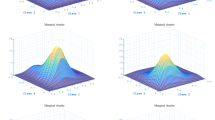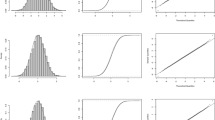Abstract
This article is a contribution to the asymptotic inference on the parameters of a quite general class of stochastic models for the spread of epidemics developing in closed populations. Various epidemic models are contained within our framework, for instance, a stochastic version of the Kermack and McKendrick model and the SIS epidemic model. Each model belonging to this class, which consists in a family of discrete-time stochastic process, contains certain parameters to be estimated by means of martingale estimators. Some particular cases defined by means of Markov chains are included in our setting. The main aim of this work is to prove consistency and asymptotic normality of these estimators. Some hypothesis tests based on the main results are also shown.
Similar content being viewed by others
References
Andersson H, Britton T (2000) Stochastic epidemic models and their statistical analysis. Lecture notes in statistics, vol 151. Springer, New York
Andersson H, Djehiche B (1997) Limit theorems for the total size of a spatial epidemic. J Appl Probab 34: 698–710
Bailey NTJ (1975) The mathematical theory of infectious diseases. Griffin & Co., New York
Ball F (1983) The threshold behavior of epidemic models. J Appl Probab 20: 227–241
Ball F, O’Neill P (1993) A modification of the general stochastic epidemic motivated by AIDS modelling. Adv Appl Probab 25: 39–62
Becker NG (1993) Parametric inference for epidemic models. Math Biosci 117: 239–251
Buckley FM, Pollet PK (2009) Analytical methods for a stochastic mainland-island metapopulation model. In: Anderssen R, Braddock R, Newham L (eds) Proceedings of the 18th World IMACS Congress and MODSIM09 International congress on modelling and simulation. Modelling and Simulation Society of Australia and New Zealand and International Association for Mathematics and Computers in Simulation, Camberra, Australia, pp 1767–1773
Buckley FM, Pollet PK (2010) Limit theorems for discrete-time metapopulation models. Probab Surv 7: 53–83
Ethier SN, Kurtz TG (1986) Markov processes: characterization and convergence. Wiley, New York
Fierro R (2010) A class of stochastic epidemic models and its deterministic counterpart. J Korean Stat Soc 39: 397–407
Hetcote H, Van Ark J (1988) Epidemiological models for heterogeneous populations: proportionate mixing, parameter estimation and immunization programs. Math Biosci 90: 415–473
Heesterbeek JAP, Dietz K (1996) The concept of R 0 in epidemic theory. Stat Neerlandica 50: 89–110
Jacquez JA, Simon CP, Koopman J, Sattenspiel L, Perry T (1988) Modelling and analysing HIV transmission: the effect of contact patterns. Math Biosci 92: 119–199
Jacquez JA, O’Neill P (1991) Reproduction numbers and thresholds in stochastic epidemic models I. Homogeneous populations. Math Biosci 107: 161–186
Kendall DG (1956) Deterministic and stochastic epidemic in closed populations. In: Proceedings of third berkeley symposium in mathematical statistics and probability, vol 4, pp 149–165
Kermack WO, McKendrick AG (1927) Contribution to the mathematical theory of epidemics. Proc R Soc Lond A 115: 700–721
Kurtz TG (1981) Approximation of population processes. SIAM Applied Mathematical Series, 36
Lefèvre C (1990) Stochastic epidemic models for S-I-R infectious diseases: a brief survey of the recent general theory. In: Gabriel JP, Lefèvre C, Picard P (eds) Stochastic processes in epidemic theory. Lecture notes in biomathematics, vol 86. Springer, New York, pp 1–12
Lehmann EL (1999) Elements of large-sample theory. Springer, New York
Lenglart E (1977) Relation de domination entre deux processus. Annales de l’Institut Henri Poincaré (B) Probabilités et Statistiques 13: 171–179
Mcvinish R, Pollett PK (2009) Limits of large metapopulations with patch dependent extintion probabilities. Appl Probab Trust:1–15
Rebolledo R La méthode des martingales appliquée á l’etude de la convergence en loi de processus. Mémoires de la Société Mathématique de France 62:1–125
Author information
Authors and Affiliations
Corresponding author
Rights and permissions
About this article
Cite this article
Fierro, R. Asymptotic distribution of martingale estimators for a class of epidemic models. Stat Methods Appl 21, 169–191 (2012). https://doi.org/10.1007/s10260-012-0186-3
Accepted:
Published:
Issue Date:
DOI: https://doi.org/10.1007/s10260-012-0186-3




